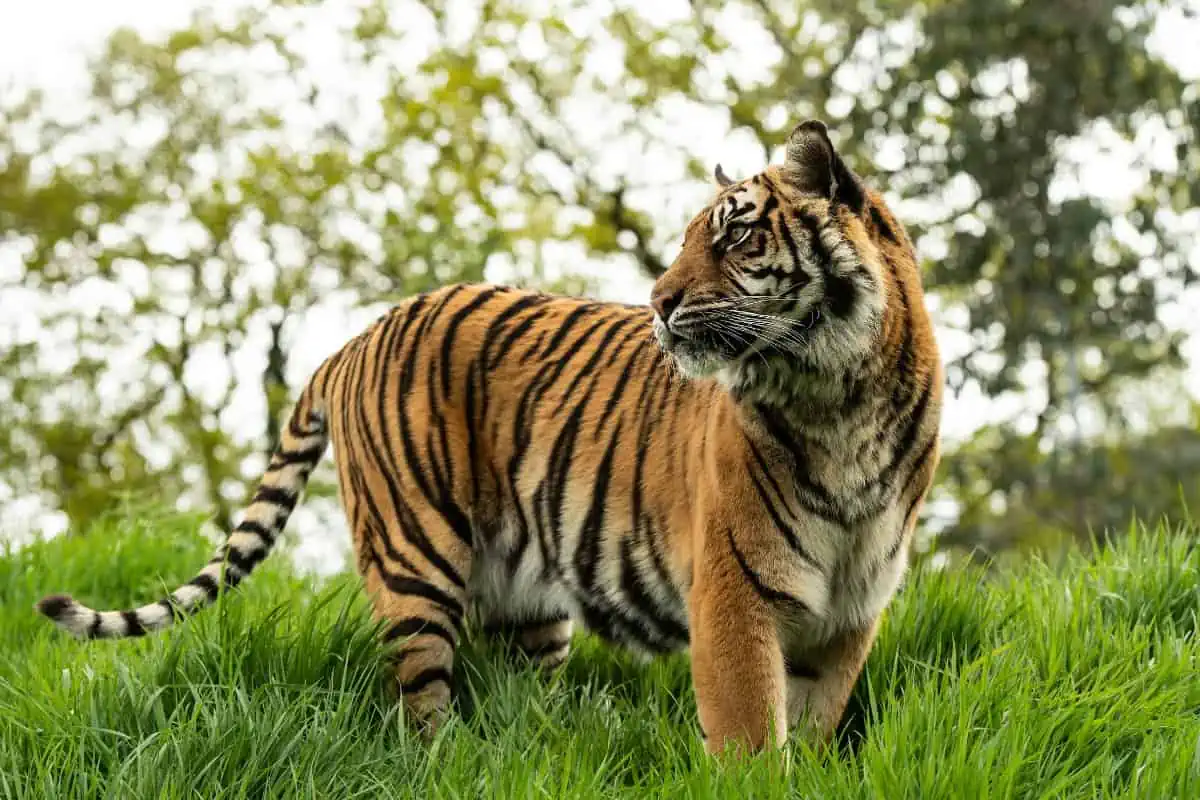Tigers are endangered; these awe-inspiring creatures face daunting challenges such as habitat loss, poaching, and human-wildlife conflict, pushing them closer to extinction.
Tiger conservation transcends the preservation of a single species. It’s crucial for maintaining biodiversity and a balanced ecosystem that supports all life forms, including humans.
Losing these apex predators would disrupt nature’s equilibrium and impact our planet’s well-being. We must act, raise awareness, and contribute to their survival.
Tiger endangerment and conservation:

Tiger Population: An Alarming Decline
Current Population Statistics
The International Union for Conservation of Nature (IUCN) Red List of Threatened Species classifies tigers as endangered.
According to recent estimates, only around 3,900 tigers are remaining in the wild.
This number is shockingly low, especially considering over 100,000 tigers were roaming the wild just a century ago.
Comparison to Historical Numbers
The decline in the tiger population is both astonishing and heart-wrenching.
When I think about how their numbers have plummeted by more than 95% over the past century, it’s impossible not to feel a sense of desperation and loss.
Deforestation, poaching for their skin, bones, and other body parts used in traditional Chinese medicine, and the relentless expansion of human settlements have all contributed to this dramatic decrease.
Distribution Among Subspecies
Today, there are six surviving tiger subspecies, each facing its unique challenges and threats.
Here’s a brief overview of their current status:
Bengal Tiger:
With an estimated 2,500 individuals left in the wild, the Bengal tiger is the most common subspecies. However, it is still classified as endangered due to habitat loss and poaching.
Indochinese Tiger:
Found in Southeast Asia, only around 350 Indochinese tigers are remaining. This subspecies is critically endangered, primarily due to poaching for the illegal wildlife trade.
Malayan Tiger:
Native to the Malaysian Peninsula, this subspecies has a population of just around 250 individuals. The Malayan tiger is critically endangered, facing threats from habitat loss and human-wildlife conflict.
Siberian Tiger:
Also known as the Amur tiger, this subspecies has a population of approximately 500 individuals, mainly in Russia. The Siberian tiger is endangered due to habitat loss and poaching for the illegal wildlife trade.

South China Tiger:
This subspecies is considered functionally extinct in the wild, with only a few individuals in captivity. Habitat loss, poaching, and lack of prey have driven the South China tiger to the brink of extinction.
Sumatran Tiger:
Found exclusively on the Indonesian island of Sumatra, only around 400 Sumatran tigers are left in the wild. These critically endangered subspecies face deforestation, poaching, and prey loss threats.
The situation may seem bleak, but we can still make a difference by supporting conservation organizations, promoting ecotourism, and raising awareness about the importance of protecting endangered tigers and their habitats.
Together, we can help ensure the survival of these awe-inspiring creatures for generations to come.
Causes of Population Decline
Poaching
Skin and Fur Trade
It’s a sickening reality that the beauty of tigers is one of the main reasons for their endangerment.
The demand for their striking skin and fur in the illegal wildlife market drives ruthless poachers to hunt them down.
These magnificent animals are killed and skinned, with their pelts sold for thousands of dollars to private collectors who display them as status symbols.
Traditional Chinese Medicine
Many people believe that tiger parts possess near-magical healing properties.
This misconception has fueled a tragic demand for tiger bones, organs, and other body parts in traditional Chinese medicine.
Despite scientific evidence proving that these supposed remedies are ineffective, the demand persists, driving poachers to hunt and kill more tigers.
Souvenirs and Mementos
Tigers are also hunted for their teeth, claws, and other body parts, which are sold as souvenirs or mementos to symbolize power and prestige.
The illegal trade in these gruesome trinkets contributes to the ongoing decline in tiger populations.
Loss of Habitat
Deforestation and Land Conversion
As humans continue to expand their agricultural and industrial activities, the tigers’ natural habitats are being destroyed alarmingly.
Deforestation and land conversion fragment the tigers’ territories, leaving them with fewer places to live, hunt, and breed. This habitat loss is a significant factor contributing to their population decline.
Impact on Tiger Behavior and Territory
The loss of habitat forces tigers to adapt to new environments or come into direct contact with humans.
These changes can negatively affect their behavior, stress levels, and reproductive success, further reducing their numbers in the wild.

Loss of Prey
Disruption of Food Chain
Habitat loss also impacts the availability of the tigers’ natural prey, such as deer, wild boar, and antelope.
As the food chain is disrupted, prey populations decrease, leaving tigers with fewer food sources and putting their survival at risk.
Effects on Tiger Survival and Reproduction
Without sufficient prey, tigers struggle to find enough food to survive and reproduce.
This lack of resources leads to weakened, malnourished individuals and fewer tiger cubs being born, resulting in a declining population.
Human-Tiger Conflict
Encroachment of Human Settlements
As human populations grow and encroach on tiger habitats, the likelihood of human-tiger conflict increases.
Tigers may be forced to enter human settlements for food, leading to dangerous encounters with people and livestock.
Retaliation and Fear-Based Killings
When tigers come into contact with humans, they may be killed in self-defense or out of fear.
Additionally, they may be killed in retaliation for attacking livestock or perceived threats to human safety.
These fear-based killings further contribute to the decline of the already endangered tiger population.
Conservation Efforts and Strategies
Legal Protection and Anti-Poaching Measures
International and National Laws
Numerous international and national laws have been enacted to protect tigers and combat illegal poaching.
One such example is the Convention on International Trade in Endangered Species of Wild Fauna and Flora (CITES), which regulates the trade of endangered species, including tigers.
Many countries have also implemented national legislation to protect tigers and their habitats, such as the Wildlife Protection Act in India.
Enforcement and Penalties
To effectively safeguard tigers, enforcing these laws and imposing strict penalties on those who break them is crucial.
Governments, conservation organizations, and local communities must work together to strengthen anti-poaching patrols, enhance surveillance, and improve prosecution and conviction rates for wildlife crimes.
Habitat Restoration and Protection
Protected Areas and Wildlife Corridors
Creating and maintaining protected areas, such as national parks and wildlife reserves, is vital to preserving tiger habitats.
Establishing wildlife corridors between these protected areas can also help tigers safely move between territories, find mates, and access prey.
This connectivity is essential for maintaining a healthy, genetically diverse population.
Sustainable Land-Use Planning
Balancing development with the need to protect tiger habitats requires sustainable land-use planning.
This involves minimizing deforestation, ensuring that infrastructure projects do not fragment tiger habitats, and promoting eco-friendly agricultural practices that reduce human-tiger conflict.
Community-Based Conservation
Involving Local Communities in Conservation Efforts
Local communities play a critical role in tiger conservation. They become invested in protecting these magnificent animals by involving them in conservation efforts, such as anti-poaching patrols and habitat restoration.
Empowering communities through education and awareness programs can help change attitudes and reduce human-tiger conflict.
Promoting Eco-Tourism and Alternative Livelihoods
Supporting eco-tourism and providing alternative livelihoods for communities living near tiger habitats can help reduce reliance on activities that harm tigers and their environments.
By creating economic incentives for conservation, communities can benefit from protecting tigers and their habitats rather than exploiting them.
Captive Breeding and Reintroduction Programs
Ensuring Genetic Diversity
Captive breeding programs can help increase tiger populations and maintain genetic diversity.
By carefully managing breeding pairs and ensuring that the offspring carry diverse genetic traits, these programs can produce healthy individuals that can be reintroduced into the wild.
Preparing Captive Tigers for Life in the Wild
To ensure the success of reintroduction programs, captive-bred tigers must be prepared for life in the wild.
This involves teaching them essential skills, such as hunting and establishing territories.
Conservation organizations must also work closely with local communities to create suitable release sites and monitor the progress of reintroduced tigers to ensure their long-term survival.

The Role of Individuals in Tiger Conservation
Raising Awareness
Education and Outreach Campaigns
As individuals, we can help raise awareness about the plight of endangered tigers by participating in education and outreach campaigns.
This can involve sharing information about tiger conservation at schools, community events, or local gatherings.
Educating others about the threats facing tigers and the importance of conservation can inspire more people to take action.
Social Media and Public Engagement
Social media platforms provide a powerful tool for raising awareness about tiger conservation.
By sharing articles, images, and videos related to the topic, we can engage the public and generate support for conservation efforts.
Participating in online discussions and joining tiger-focused groups can also help amplify our voices and reach a wider audience.
Responsible Consumer Choices
Avoiding Products Containing Tiger Parts
One of the most significant threats to tigers is the illegal trade of their body parts. As consumers, we can help combat this by refusing to purchase products made from tiger parts or derivatives.
This includes traditional medicines, clothing, and souvenirs. By reducing demand, we can discourage poaching and help protect tigers in the wild.
Supporting Companies with Ethical Sourcing Policies
We can also make a difference by supporting companies with ethical sourcing policies.
This means choosing products from companies prioritizing sustainable practices and avoiding contributing to habitat destruction or wildlife exploitation.
We can encourage businesses to adopt more eco-friendly practices by voting with our wallets.
Supporting Conservation Organizations
Donating to Tiger-Focused Charities
Financial support is crucial for conservation organizations working to protect endangered tigers.
Donating to tiger-focused charities can help fund anti-poaching efforts, habitat restoration projects, and community-based conservation initiatives.
No matter how small, every contribution can make a difference in the fight to save these magnificent animals.
Volunteering and Participating in Conservation Events
In addition to providing financial support, we can also contribute our time and energy by volunteering with conservation organizations or participating in conservation events.
This could involve joining local clean-up efforts, assisting with educational programs, or participating in fundraising activities.
By getting involved, we can directly impact tiger conservation and help ensure their survival for generations to come.
Final Thoughts
Endangered tigers face numerous challenges, including poaching, habitat loss, prey depletion, and human-tiger conflict.
With populations at an all-time low and the survival of some subspecies hanging in the balance, it’s crucial that we address these issues and implement effective conservation strategies.
We must engage in collective action to truly make a difference in the fight to save endangered tigers. This means not only supporting conservation efforts on a global scale but also making responsible choices in our daily lives.
Every individual can play a part in protecting these majestic animals, and together, we can help ensure their survival for generations to come.
Now that you know the challenges endangered tigers face and the various ways we can help, it’s time to take action. Whether it’s raising awareness, making responsible consumer choices, or supporting conservation organizations, every effort counts.
Get involved and encourage others to do the same. By working together, we can give tigers the fighting chance they need to thrive in their natural habitats and preserve their rightful place in our world’s rich biodiversity.
